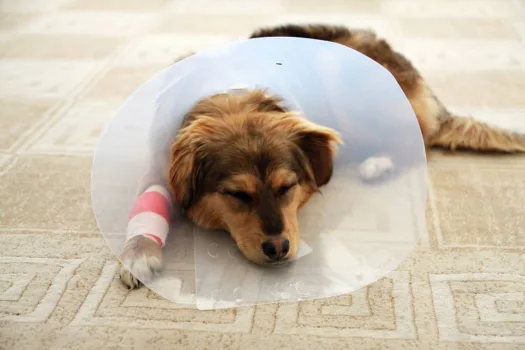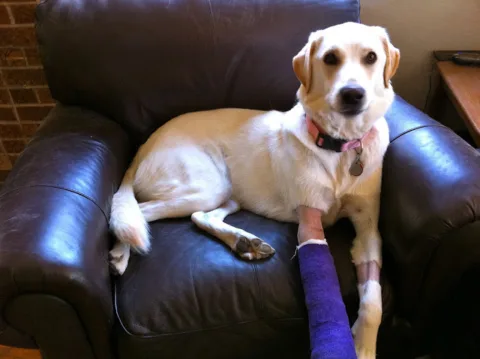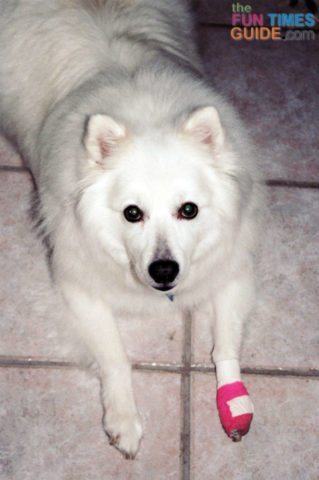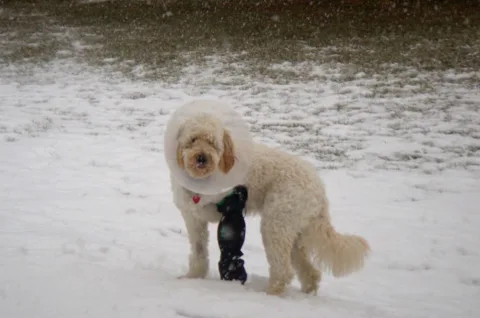If your dog has sustained an injury that requires bandages or a cast until the affected area heals, then you will need to do everything in your power to keep that area completely dry until the bandages are removed.
This is usually easier said than done. I know. My dog had bandages for a hot spot that he had to keep on for several weeks.
Of course baths are out of the question during this time. But what if it also starts to rain or snow?
The answer: You must figure out a way for your dog to go outside without getting the cast or bandages wet.
Here are some viable options…
(For the record, the following information applies to human casts and bandages, as well as those used on pets.)
Ways To Keep A Pet Cast (Or Bandages) Dry
Your safest course of action is to follow this 3-step procedure:
- Wrap a washcloth or towel (at least paper towels) around the top of the cast.
- Then put a thick, heavy-duty plastic bag (like a Hefty trash bag) over the cast/bandage.
- Wrap another towel over the plastic bag, and tape securely with duct tape to keep everything in place.
A similar idea is to place a disposable plastic bag (the kind you get at grocery stores) over the cast or bandage. Then, secure it onto the limb with a loose rubberband, an extra-large twist-tie (the kind you find on broccoli & other fruits and vegetables in the supermarket), clear tape, or masking tape. Just be sure to remove the rubberband or twist-tie immediately after returning indoors… you don’t want to cut off the circulation! Placing the rubberband, etc. on top of the cast or bandage itself is your safest option — as opposed to securing it in place directly around your dog’s limb.
You could also wrap the bandage/cast in some self-sticking Glad Wrap before your dog goes outdoors in the rain or snow.
In a light rain or snow, you may be able to place a standard sock over the bandage or cast for the brief time that your dog will be outdoors.
You could even wrap the bandage/cast in some self-sticking Glad Wrap before your dog goes outdoors in the rain or snow.
They make waterproof cast covers specifically for this purpose — for humans. Chances are, you’ll be able to find one that will fit your dog’s small size.
If the bandages are confined to the dog’s paw, a pair of dog boots may suffice. They make disposable dog booties, as well as high-quality, durable dog boots. Keep in mind, you’ll probably need a size or two larger than your dog’s actual paw size — in order to accommodate the bulky bandaging. I know that my dog’s ‘regular’ pair of dog boots would not have worked since they’re tight-fitting.
If the bandages are on your dog’s head, body, or back of the neck, then a dog raincoat might work. Most dog raincoats have hoods attached. Again, you may need a size larger than your dog’s regular size in order to accommodate the bandages.
Finally, you could simply hold an umbrella over your dog (while on a leash). Just watch closely to make sure your dog doesn’t step in a puddle or heap of snow and get the bandages wet that way. They even make pet-sized dog umbrellas that would be ideal!
What To Do If The Cast Gets Wet

If a part of the cast gets wet, you can dry it with a blow-dryer on the “Cold” setting.
According to Judy Adcock, RN-C, NCI:
- If a fiberglass cast gets wet, it MUST be dried. Fiberglass is heat conductive, so you must use a very cool hair dryer or a fan, to prevent burns. Hold the hair dryer away from the cast and move it back and forth over the wet area. Do this for only 5 minutes at a time. Do not try to blow the air up and down the ends of the cast; this will not get the cast dry.
- If a plaster cast gets wet, it must be replaced. Once wet, it is no longer structurally sound.







